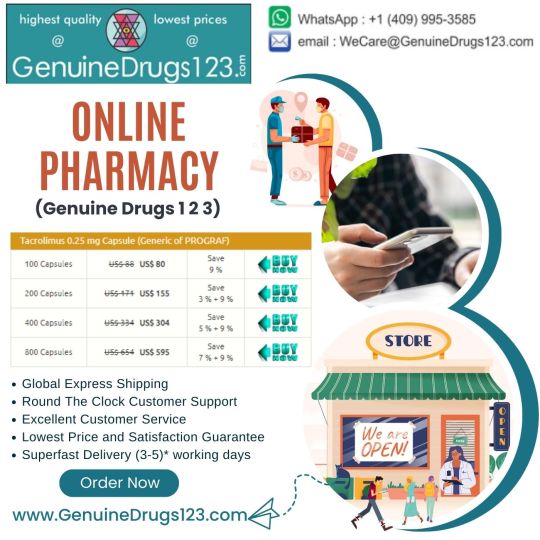Don't wanna be here? Send us removal request.
Text

(Tacrolimus) Prograf - Global Availability & Affordable Prices
Make sure global access to essential health product at affordable prices is crucial for public health. Joint efforts among nations, companies, and NGOs are vital to address gaps. By raising fair pricing strategies and reducing trade barriers, we can create a healthier world where everyone has equitable access to life-saving (Tacrolimus) Prograf, Protopic.
0 notes
Text
Change to in-use shelf-life of Prograf (immediate-release tacrolimus) capsules
The in-use shelf-life of Prograf® (immediate-release tacrolimus) capsules once removed from the inner protective aluminium wrapper has changed from 12 months to three months. This change is in response to recent stability testing undertaken by the drug sponsor. The change was approved by the Therapeutic Goods Administration (TGA) in December 2021 and updated in the Australian Product Information and Consumer Medicine Information in March 2022. As the drug sponsor.
transitions to new packs, the TGA has permitted the continued use of Prograf packs with the 12 month in-use shelf-life printed on the box. However, use must comply to the new three month in-use shelf life. At the time of publication, no other brands of tacrolimus capsules (immediate or controlled release) are affected by this change.
Prograf is indicated for use as an adjunct to liver, kidney, lung or heart allograft transplantation in adults and children.
Prograf is available in 0.5 mg, 1 mg and 5 mg capsules. They are supplied in blister strips of 10 capsules, packaged within an outer protective aluminium wrapper which reduces light exposure.
A product expiry date is the date printed on the medicine’s outer packaging (box). The in-use shelf-life is the period after opening the inner protective aluminium wrapper that a medicine is considered safe and efficacious to use. Once the inner wrapper is opened, the expiry date should be clearly documented on the product’s outer packaging or the dispensing label. Any medicine remaining should be discarded by the in-use shelf-life end date or the product expiry date, whichever comes first.
0 notes
Text
Tacrolimus (Prograf) Side Effects
Tacrolimus is an immunosuppressant medication used to prevent organ rejection in transplant patients and is also indicated in the treatment of atopic dermatitis. Side effects of tacrolimus include nephro- and neurotoxicity, infection, diarrhea, nausea, vomiting, hypertension, hyperkalemia, and hyperglycemia. Patients taking tacrolimus should not drink grapefruit juice, as it prevents the drug from being metabolized and can lead to toxicity.
0 notes
Text
Tacrolimus Once Daily (ADVAGRAF) Versus Twice Daily (PROGRAF)
Tacrolimus (Prograf, Astellas Pharma Europe Ltd, Staines, UK; referred to as Tacrolimus BID), an established immunosuppressant for the prevention and treatment of allograft rejection in kidney, liver and heart transplantation, is administered twice daily (BID). A prolongedrelease tacrolimus formulation (Advagraf, Astellas Pharma Europe Ltd, Staines, UK; referred to as Tacrolimus QD) allows once-daily dosing, with the potential for improving treatment adherence. Nonadherence is a major cause of preventable graft loss (1–3). Interventions that improve treatment adherence, such as morning dosing and reducing administration frequency (4,5), may also improve longterm outcomes (6–8).
Both tacrolimus formulations have demonstrated comparable steady-state systemic tacrolimus exposure in stable and de novo kidney and liver transplant patients. Importantly, the relationship between trough levels and systemic exposure was identical (9), and thus enabled monitoring by trough levels as a surrogate for area under the curve as used with Tacrolimus BID. This study was performed to yield further results comparing Tacrolimus BID and QD formulations in a double-blind fashion in combination with low-dose mycophenolate mofetil (MMF) and corticosteroids without antibody induction.
0 notes
Text
What is PROGRAF?
PROGRAF is a prescription medicine used with other medicines to help prevent organ rejection in people who have had a kidney, liver, or heart transplant and PROGRAF is not for use with medicines called cyclosporines (Gengraf®, Neoral®, and Sandimune®).
PROGRAF is not for use with a medicine called sirolimus (Rapamune®) in people who have had a liver or heart transplants. It is not known if PROGRAF is safe and effective when used with sirolimus in people who have had kidney transplants. It is not known if PROGRAF is safe and effective in children who have had a kidney or heart transplants.
0 notes
Text
tacrolimus injection (for intravenous infusion only)
Prograf is available for oral administration as capsules (tacrolimus capsules) containing the equivalent of 0.5 mg, 1 mg or 5 mg of anhydrous tacrolimus. Inactive ingredients include lactose, hydroxypropyl methylcellulose, croscarmellose sodium, and magnesium stearate. The 0.5 mg capsule shell contains gelatin, titanium dioxide and ferric oxide, the 1 mg capsule shell contains gelatin and titanium dioxide, and the 5 mg capsule shell contains gelatin, titanium dioxide and ferric oxide.
Prograf is also available as a sterile solution (tacrolimus injection) containing the equivalent of 5 mg anhydrous tacrolimus in 1 mL for administration by intravenous infusion only. Each mL contains polyoxyl 60 hydrogenated castor oil (HCO-60), 200 mg, and dehydrated alcohol, USP, 80.0% v/v. Prograf injection must be diluted with 0.9% Sodium Chloride Injection or 5% Dextrose Injection before use.
1 note
·
View note